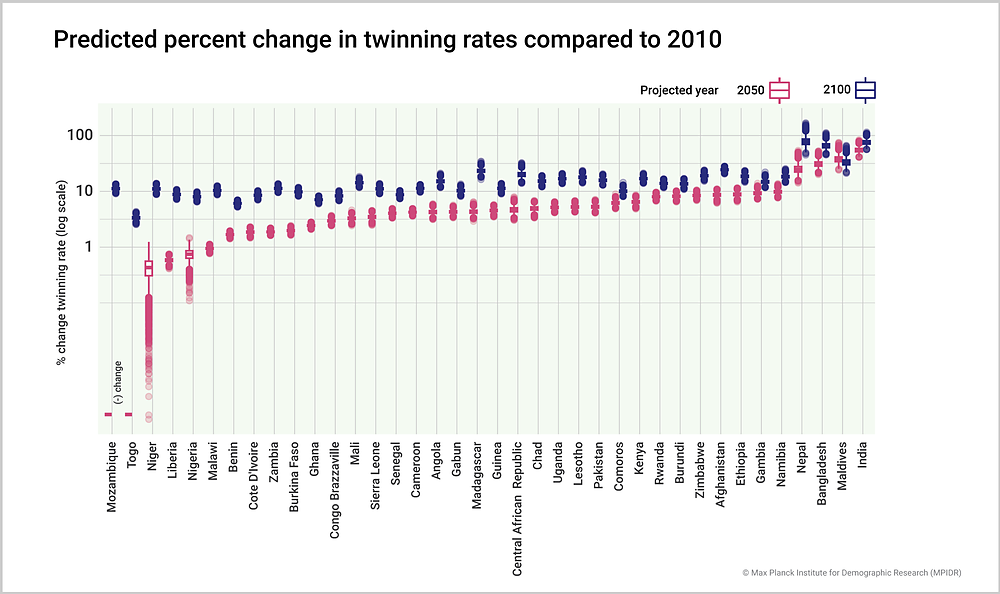February 14, 2025 | News | New Publication
Twin births: A growing trend in low-income countries
New study predicts rise in twin births by 2100
The number of mothers giving birth at an older age is increasing in many countries in sub-Saharan Africa and southern Asia. This leads to a higher likelihood of multiple births, which are mostly twins. A study by the Max Planck Institute for Demographic Research (MPIDR) has found that the rate of twin births in low-income countries could increase significantly by 2100 even if the spread of assisted reproductive technology such as IVF remains slow. The findings call for better maternal and perinatal care in these countries.

The number of twin births will increase significantly in sub-Saharan Africa and South Asia, says a current study by D. Susie Lee and Kieron J. Barclay. © istockphoto.com / DisobeyArt
In many countries in sub-Saharan Africa and South Asia, women are giving birth at an older age than in the past, and this trend is expected to continue. The later in life a woman has a child, the greater the likelihood of multiple births due to the increased polyovulation rate. Using this knowledge from reproductive biology, Dr. Susie Lee of the Max Planck Institute for Demographic Research (MPIDR) and Kieron J. Barclay of Stockholm University have now investigated how changes in the age distribution of mothers are associated with changes in twin birth rates at the population level in low-income countries.
Their study is based on data from the Demographic Health Surveys and the World Fertility Surveys. "We first estimated the age-specific probability of twinning. Then we extrapolated the age-specific twin probability to the population level for each country, to project how the number of twin births will change in 2050 and 2100 if the age of mothers shifts to a later age as predicted by the UN World Population Prospects," explains Susie Lee, corresponding author of the study.
To estimate the age-specific twin probability and country-specific twinning rates, the researchers analyzed data from around 3.19 million births. The majority of these births took place between 1980 and 2015 in 39 countries where assisted reproduction was rarely used at the time.

The figure shows the predicted percent change in 2100 in twinning rates compared to 2010. © MPIDR
The study found that the rate of twin births in low-income countries could increase significantly by 2100 due to the increasing age of mothers. "Our estimation suggests that delayed childbearing alone will result in one out of every 40 children in Nepal having a twin sibling by 2100, compared to one out of every 72 in 2010. The same comparison for Niger, on the other hand, is estimated to be one out of 29 in 2100 vs. one out of 26 in 2010, due to the relatively slower shift in maternal age structure projected for this country,," says the scientist. India will continue to have the highest proportion of twin births due to its large population, although the number of twin births is expected to fall by 10.5 per cent by 2100. Nigeria is expected to have the second highest number of twin births, not only because of its large and growing population, but also because of its high rate of twin births.
Multiple pregnancies are associated with higher risks during and after pregnancy. Mothers are more likely to fall ill or die during or after childbirth. Children of multiple births are more likely to have developmental problems. In sub-Saharan Africa, the gap in under-five mortality between twins and singletons has widened in recent decades. This suggests that twins have benefited less from the overall decline in child mortality.
"Our findings underscore the need for greater public health attention to multiple births in many low-income countries. The early childhood survival rate of multiples is still lower than that of singletons, especially in the first year of life. And as our study suggests that more multiples are being born, it remains an important task to ensure that they survive the first year of life as well as singletons," says Lee.
Original Publication
D Susie Lee, Kieron J Barclay: More twins expected in low-income countries with later maternal ages at birth and population growth in Human Reproduction (2024) DOI: 10.1093/humrep/deae276
Keywords
twinning rate, maternal age structure, Demographic Health Surveys, UN World Population Prospects, sub-Saharan Africa, Southern Asia